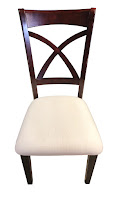 |
| Drum Table Painted |
 |
| Drum Table Before |
A classic drum table is one of the most loved furniture items in traditional homes. This popular table has many uses and can fit almost anywhere. This drum table had a unique top with what we originally thought to be leather, but it had a paper origin and couldn’t be removed, so stripping and staining it was not an option. I recommend painting it black and it was unanimously agreed that would be the best solution for the most attractive outcome.
This table had wheels that were kept, but in addition to the original brass hardware needed cleaning. It’s amazing just how great brass hardware polishes up. What you almost don’t notice becomes the star of the show! Hardware is like the “bling” or jewelry for any furniture. If you like the original look but want to it show up better, polishing it is a great option. We’ve also had luck with painting hardware when polishing either isn’t desired, or the customer wants a different color. So many choices!
Many of these tables were made in the late 1930’s, but some, like this one, is a reproduction. You can usually tell by looking at how the table is assembled whether or not is is an original. Older, antique furniture makers used much larger screws and their assembly techniques were significantly different than factory reproductions. The antiques are actually easier to work on because the wood is usually much higher quality and refinishes perfectly.
There are some die-hard traditionalists that don’t like the look of painted furniture, but sometimes it’s the best option when the wood used either isn’t that great (as in mixing and matching) or doesn’t take the stain well. In our experience, if a piece comes to us painted, there’s a 50/50 chance it won’t stain well. But each piece has a different story and history, so until you strip, you can’t know for sure. But one thing is for certain and that is the end result is always better than what you started with, no matter what option you choose.
































